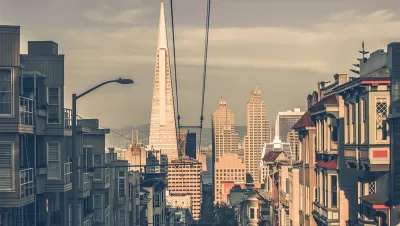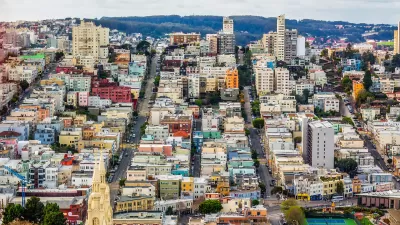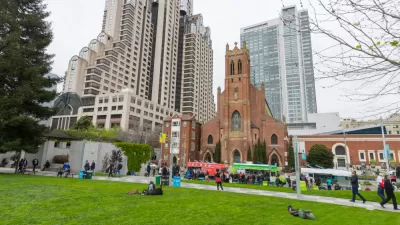The latest installment of the Planners Across America series interviews John Rahaim, planning director for the City and County of San Francisco, about the heightened passions and perpetual controversies of planning in the City by the Bay.

Wonderful, intangible things come out of San Francisco these days: games to play, cars to pick you up, engines to search the world’s information. But all of the frenetic energy of the tech world—not to mention the comings and goings of everyday San Franciscans—has to take place in real space. In the case of San Francisco, it’s a tight space: seven miles by seven miles, full of some of the most historic architecture, strongest personalities, progressive ideas, most breathtaking views, and costliest real estate in the country.
No urban issue is too big or too small for San Francisco, from the city’s dire housing crisis to the promotion of parklets. Overseeing this cauldron of activity is John Rahaim, planning director for the City and County of San Francisco. He spoke with Planetizen about the challenges and delights of planning in San Francisco as the latest installment of "Planners Across America"—a series of interviews of big city planning directors.
What are your top priorities at this moment?
 Clearly the most overwhelming and critical issue facing San Francisco right now is affordable housing and, more broadly, the whole equity and inclusiveness issue. Affordable housing is clearly the key issue that we're facing, particularly as a planning agency right now.
Clearly the most overwhelming and critical issue facing San Francisco right now is affordable housing and, more broadly, the whole equity and inclusiveness issue. Affordable housing is clearly the key issue that we're facing, particularly as a planning agency right now.
The city's population is growing at a rate that it hasn’t seen since World War II. Ten thousand people per year are moving in, and there's some expectation that the rate of growth actually going to increase. We have 7,000 units under construction, which, for us, is an awful lot, but it's not keeping up with demand. We have the dubious distinction of having the most expensive housing market in the country right now, even higher than New York.
What are the solutions on the horizon?
The mayor, to his credit, convened a housing task force last year. We went through months of work on a range of solutions. The city has had an inclusionary housing program for a long time. We are looking to expand that, particularly to see if we can expand it to include middle-income, which is the element of the city's income strata that is the least-served right now. There's nobody building housing for the 80-120 percent area median income category.
We've started a Public Sites Program where we’re looking at city-owned parcels that could be redeveloped, leased, or sold for development to include low- and middle-income housing. For instance, we have a very large site that could accommodate 600 units.
There are several large sites in the development pipeline where the developers, because the size of the parcels and the nature of the development, are able to achieve a much higher percentage of affordable housing. One has 33 percent, another has 40 percent. Partly it’s being driven and enabled by the fact that the market-rate housing is achieving such high prices.
What are some of the more fun innovations you're working on?
I'm proud of the work that we’ve done in the public realm. The parklet program was kind of our invention. We've expanded that in the Pavement to Parks Program, which is looking at unused roadways. What's particularly interesting about it is that it's a short-term intervention: developing a scheme and making it happen in a weekend. It's paint and potted plants and interesting found materials in the Public Works yard.
What is even more interesting in my mind is the recent Prototyping Festival. We worked with a local arts organization, the Yerba Buena Center for the Arts. They supported us on this four-day festival where teams developed built objects in the right of way along Market Street and engaged the public. It was an enormous success: things that were interactive, things that played music, there was a six-sided ping-pong table that lit up when you played. Incredibly cool stuff. That's being used as a prototype or some permanent installations along Market Street as we plan for the rebuilding of the street in the next five years.
The public realm stuff is fun, exciting, and engaging, and it’s very important as the city densifies to use the rights of way in more creative ways.
Being the technology capital of the world, how does tech play into your work?
I don't mean to downplay it; I think there's a willingness to accept it here. But I'm not sure it actually influences us more than it does in other cities. We have some things that we're very proud of. The parking program that the MTA has put forward is a very interesting thing. We have our interactive property information map, which uses Google maps and GIS to find information about any parcel in the city just by clicking on it.
One of the things we're just starting to get into is electronic plan reviews. We're a little behind on that front with respect to some other cities in terms of online applications and online reviews. What we've tried to do with technology is instead of using it for our day to day work, we're using it to engage the public: using social media and using information map to better inform what we’re doing.
What are the prospects for autonomous cars?
Uber and Lyft and that whole genre of transportation is here to stay. It's offering a real service to people. I've spoken to lots of people who say they have stopped or drastically limited driving their own cars.
I don't think driverless cars in and of themselves solve a transportation problem. I think they do greatly help to solve, potentially, the car storage problem. I think that driverless cars will only be really helpful if they effectively become part of a public transportation system.
The fear I have about these systems is that it creates a two-class transportation system. We see that happening here with startups offering their own bus routes for three or four times the price of a normal bus. I think there's a real danger in that. If there's a way to make it work as part of the public transit system, that would be hugely beneficial.
How does your department handle all the activity in San Francisco?
There are 50,000 units in the pipeline, 7,000 under construction. Of that 50,000, there are about 38,000 that are fully entitled.
The department has grown about 40 percent over the past four years, from about 160 people to 220 people. Our revenues are largely from the development fees, not from taxes. My general fund portion of my budget is down to 5 percent. We had to ride the wave of development booms and busts here. We are the largest we've ever been.
One of the constant refrains we have in the city is how long it takes to get projects through the system just because of the sheer volume of projects. Even without this development boom, my planning department has to review more projects than any city in the U.S., including Los Angeles and New York. It's because of the nature of our code; it requires a formal review as opposed to what's over the county. New York reviews about 400 projects per year. My department reviews over 2,000.
Do those reviews result in a better built environment?
I think where we do well, rightly or wrongly, is in maintaining the texture of the city. That's a silly, "planner-y" word. But most new development, large and small, is inserted into the city in a thoughtful way. It doesn't mean that the only way to do that is to have these very intensive reviews even on very small projects, but that’s the system that San Francisco has evolved, because there's such a high level of citizen involvement and engagement.
What's it like to engage in discussions with San Francisco's impassioned stakeholders?
In some ways, it's no different than anywhere else. It's just more acute and higher pitched here. There's a very high level of knowledgeable and smart people on all sides of these issues. You can have a thoughtful professional-level conversation. That doesn’t mean people aren't emotional, but people understand the issues on all sides.
What I get frustrated about is the extreme positions that people take. I actually think there's far more agreement than people want to admit. People stake out extreme positions because they think it will help them win. That happens on both sides of these arguments.
What we try to do is steer a middle course. Frankly, I think we are as apolitical as any planning department in the country. I go out of my way not to show that I am supporting a particular elected official or point of view. We try to base our work on facts and on our professional-level analysis. We spend a lot of time doing research, collecting data, and monitoring conditions.
There's a big group of angry, vocal people about changes in the city, who believe that housing supply is not part of the solution. They believe it is part of the problem. I believe strongly that that's not the case. I also believe that it's not just building thousands and thousands of units is not the only solution.
The proverbial Twitter and Uber employees: how engaged are they in these civic discussions?
It varies. The city's second-largest employer is Salesforce.com. They will occupy what will be the highest tower on the West Coast. They have been engaged in an enormous way. Marc Benioff, the CEO, has been a huge contributor to civic causes. For many of the younger, smaller firms, it's a mixed bag.
There's an interesting organization with a terrible acronym called SF BARF who are advocating for more housing. They're mostly Millennials. I don't see them in huge numbers, to be honest. I think they're living their lives and working their butts off.
I got to Seattle in 1999. At that point Bill Gates was routinely criticized in the media for not giving away enough of his money. Now he has the biggest foundation on the planet. I think there's a maturity that's not yet a habit with a lot of these smaller companies. That will happen.
You're an architect by training. What got you interested in planning and what keeps you in it?
I grew up in Detroit and went to architecture school at the University of Michigan. I was fascinated by the environment around me. That grew out of at Jesuit education in Detroit where they pushed us to be engaged in the city. I worked after undergraduate for a firm named Albert Khan and Associates. Then I went to grad school at University of Wisconsin-Milwaukee. I realized that my interest was not in individual buildings but my real talent was in how buildings work together and how systems work in cities.
I started with the Pittsburgh Planning Department in 1984. Pittsburgh at that time was doing some really interesting work, especially in the downtown. Because it was a lot smaller city and a much smaller range of functions, I was able to do everything from write zoning codes to review developments to urban design. I came to Seattle in the late 1990s and started the city's first urban design office. At this point in my career, I'm the most challenged but having the most fun.
Do you have intellectual influences? Or is San Francisco in its own universe?
San Francisco likes to think of itself as its own universe. But we deal with global forces. Ed Glaeser’s book, Triumph of the City, is very interesting to me. Jane Jacobs was very influential in terms of my thinking. The program that I went to at University of Wisconsin-Milwaukee was a very humanist-based program—a very unusual architecture program. The chair was an environmental psychologist. That had a great influence on me in terms of thinking about the interaction of people’s behavior and the physical environment.
I have been reading more recently a lot about the history of San Francisco just because I think it's important for me to understand where the current climate came from. I just finished Season of the Witch, a fascinating era in the city's history. And my staff does a lot of research.
What insights can you offer to or gain from your counterparts elsewhere? Is San Francisco unique, or can you share?
What I find interesting about that group is the growing cities and the post-industrial cities and the a huge gap there. There's the San Franciscos and Bostons and Seattles, and there's the St. Louis and Detroit and Buffalo and Cleveland folks. The distinctions are, as far as I can tell, growing.
[Conducted in June, this interview has been edited and condensed.]

Planetizen Federal Action Tracker
A weekly monitor of how Trump’s orders and actions are impacting planners and planning in America.

Restaurant Patios Were a Pandemic Win — Why Were They so Hard to Keep?
Social distancing requirements and changes in travel patterns prompted cities to pilot new uses for street and sidewalk space. Then it got complicated.

Map: Where Senate Republicans Want to Sell Your Public Lands
For public land advocates, the Senate Republicans’ proposal to sell millions of acres of public land in the West is “the biggest fight of their careers.”

Maui's Vacation Rental Debate Turns Ugly
Verbal attacks, misinformation campaigns and fistfights plague a high-stakes debate to convert thousands of vacation rentals into long-term housing.

San Francisco Suspends Traffic Calming Amidst Record Deaths
Citing “a challenging fiscal landscape,” the city will cease the program on the heels of 42 traffic deaths, including 24 pedestrians.

California Homeless Arrests, Citations Spike After Ruling
An investigation reveals that anti-homeless actions increased up to 500% after Grants Pass v. Johnson — even in cities claiming no policy change.
Urban Design for Planners 1: Software Tools
This six-course series explores essential urban design concepts using open source software and equips planners with the tools they need to participate fully in the urban design process.
Planning for Universal Design
Learn the tools for implementing Universal Design in planning regulations.
Heyer Gruel & Associates PA
JM Goldson LLC
Custer County Colorado
City of Camden Redevelopment Agency
City of Astoria
Transportation Research & Education Center (TREC) at Portland State University
Camden Redevelopment Agency
City of Claremont
Municipality of Princeton (NJ)





























